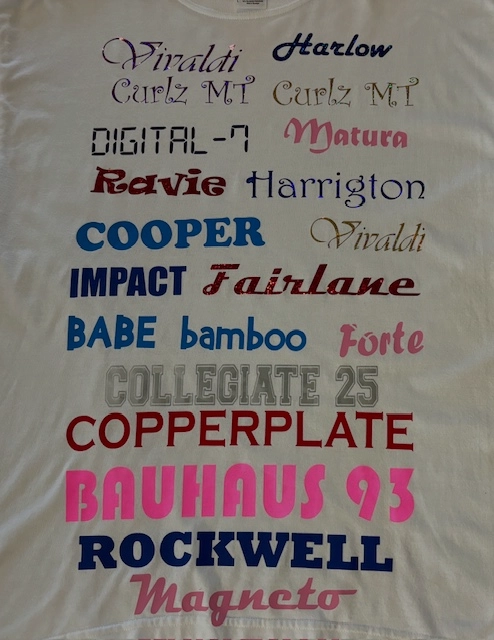The Art of Custom-made Embroidery: Opening the Secrets to Creating Special and Remarkable Styles
Needlework, a craft soaked in tradition and virtuosity, holds within its intricate stitches the power to change fabric right into a canvas of unique expression. The keys to developing custom-made needlework designs that astound the eye and leave a long-term impression lie in a fragile balance of technique, imagination, and focus to detail. As we delve right into the globe of customized embroidery, we reveal the nuanced interaction between string option, stitch intricacy, and layout personalization that boosts a simple garment to an artwork. Join us on a journey through the art of custom-made embroidery as we untangle the secrets behind crafting truly extraordinary and distinctive creations.
Choosing the Right Needlework Threads
When picking embroidery threads, what essential factors should you consider to make sure the finest results for your custom designs? The option of needlework string is important in establishing the last outcome of your stitched style.
Thicker strings can include dimension and texture to your layout, while finer threads are optimal for complex details and tiny text. Furthermore, thinking about the shade fastness and washability of the thread is essential to guarantee that your custom designs keep their top quality and vibrancy over time.
Checking Out Various Stitch Techniques
To dive into the realm of 'Exploring Different Stitch Methods', one have to comprehend the ins and outs and nuances that each sewing technique brings to the art of embroidery. Various stitch strategies not only add visual rate of interest however likewise contribute to the general texture and dimension of the style. One preferred stitch method is the satin stitch, which involves very closely jam-packed parallel stitches to produce a smooth and shiny surface, suitable for filling out forms and developing bold describes.
On the other hand, the backstitch is a functional strategy usually used for describing and adding great information. It entails sewing backwards to develop a strong line of embroidery. Furthermore, the French knot stitch adds a responsive component to styles, ideal for developing textured accents like blossom centers or ornamental touches.
Discovering various stitch methods allows embroiderers to have fun with light, darkness, and depth within their layouts, elevating the visual charm and creative quality of their embroidery projects. By understanding different sewing techniques, one can open endless possibilities for developing distinct and memorable custom embroidery pieces.
Incorporating Personalized Style Elements
Having checked out the details of various stitch strategies such as the satin stitch, backstitch, and French knot, the focus currently visit here shifts towards integrating individualized design aspects in personalized needlework tasks. Customized layout aspects play a critical duty in making embroidery projects really my website distinct and memorable. One means to incorporate personalization is by adding initials, names, or significant days to the layout. This not just includes a personalized touch but additionally boosts the nostalgic value of the embroidery item.
One more means to include individualized style aspects is by consisting of signs or themes that hold special significance to the recipient or reflect their rate of interests and individuality. For example, incorporating a preferred flower, animal, or hobby-related icon can make the embroidery style much more purposeful and individualized. In addition, choosing shades that resonate with the recipient or line up with the desired theme can additionally improve the customization of the needlework task.
Understanding the Art of Shade Coordination

One trick element of color coordination is understanding color concept. This includes understanding just how various colors communicate with each other, the feelings they share, and exactly how they can be incorporated to produce aesthetically attractive designs. By applying visit this page shade theory principles, embroiderers can develop unified color combinations that improve the overall look of the style.
Furthermore, taking notice of comparison is crucial in shade coordination. Making use of contrasting colors can assist specific aspects of the style pop, improve legibility, and produce an aesthetically vibrant needlework item. By understanding the art of shade control, embroiderers can raise their layouts and create unforgettable pieces that reverberate with customers and visitors alike.
Enhancing Appearance With Advanced Needlework Stitches
French knots, for example, are ideal for adding tiny, increased dots to your layout, mimicking the appearance of beads or producing a distinctive surface. Bullion knots, on the various other hand, can be made use of to create twisted, ropelike aspects that include an elegant feel to the needlework. Seed sewing entails tiny, scattered stitches that can fill out areas with a polychromatic texture, while turkey job produces fluffy, dimensional accents evocative animal fur or foliage. Trying out these advanced needlework stitches enables you to press the borders of conventional needlework and create absolutely distinct and aesthetically appealing appearances in your styles.
Conclusion
In final thought, the art of custom embroidery involves a mix of choosing the right strings, discovering numerous stitch methods, incorporating customized design components, mastering shade control, and enhancing structure with innovative stitches. By recognizing and executing these crucial elements, embroiderers can develop distinct and remarkable layouts that showcase their creativity and skill. Needlework lovers can open the tricks to creating gorgeous and custom items that stand out and leave a lasting perception.